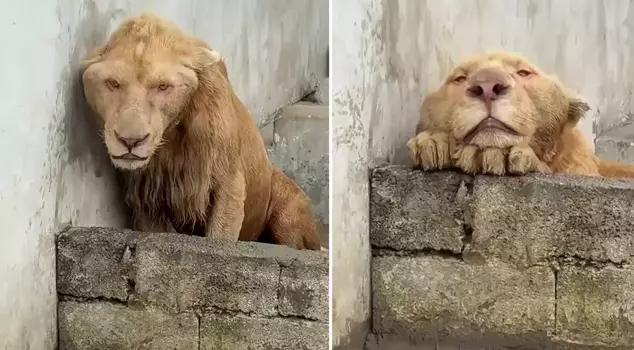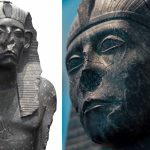Neo the Gentle Lion: The Real Story Behind the Myth

For years, social media has had a complicated relationship with truth—something beautifully illustrated by the rise of the story known as “Neo the Gentle Lion.” Depending on where someone first encountered his name, Neo was either a real rescued big cat living quietly in a South African sanctuary… or a mystical lion in the wild whose gentle heart transformed his pride and challenged everything we think we know about dominance in the animal kingdom. The problem, of course, is that only one of these Neos ever existed.
Yet both versions—one factual, one fictional—have fused together in the public imagination, creating a figure who is part reality, part digital folklore, and entirely shaped by our modern craving for stories about empathy, difference, and unexpected forms of strength.
The Viral Myth
The viral version of Neo first exploded across platforms like Facebook, TikTok, and Instagram. Posts featured images—sometimes beautiful, sometimes uncanny—of a lion with unusually rounded features, soft eyes, and an expression that internet users quickly labeled as “gentle.” These images were, as is often the case now, AI-generated or heavily manipulated. They showed a lion with exaggerated childlike traits: smoother fur, a slightly shortened face, or a gaze that seemed almost human.
Alongside these images ran a narrative describing Neo as a lion “born different.” Some posts even claimed he had a “condition like Down syndrome,” a comparison that is scientifically impossible for lions. But in the world of algorithm-driven storytelling, biological facts mattered little. What mattered was the emotional effect. The story said Neo was bullied or rejected by his pride, only to win them over not through strength or dominance, but by kindness. He supposedly protected cubs, resolved conflicts, brought calm during territorial tensions, and encouraged peaceful coexistence where aggression once ruled.
This version of Neo existed as a symbol, not an animal—a gentle soul whose difference made him extraordinary. It was a modern fable disguised as a real wildlife account.
Millions shared the posts, often with comments like “animals are better than humans” or “this is proof that kindness is powerful.” And in a way, the viral Neo became exactly that: a vessel for comfort, hope, and soft-hearted optimism.
But he was never real.

The Real Neo: A Lion Rescued, Not Invented
What many people don’t know is that behind the digital myth, there truly was a lion named Neo—just not the one social media portrayed.
The real Neo lived at LIONSROCK Big Cat Sanctuary in South Africa, a refuge operated by the global animal welfare organization FOUR PAWS. His journey was far less glamorous than the viral legend, but considerably more meaningful. Born in captivity, Neo did not come from the wild. Instead, he was rescued from a safari park in Austria in 2007 alongside two other lions, after authorities determined that the conditions there were unsuitable and potentially dangerous for the animals.
When Neo first arrived at LIONSROCK, caretakers described him as cautious but unusually gentle. He was not aggressive, even when stressed. He seemed to prefer observing to asserting himself. Over time, he bonded with caregivers and showed a soft, stable temperament—rare but not unheard of in captive lions.
Neo spent nearly two decades living in spacious enclosures, receiving veterinary care, enrichment, and a life far more natural than anything he had experienced before. Staff often spoke about his calm presence. He was, in a very real sense, a gentle lion—but gentle in a biological, not mystical, way. He wasn’t reshaping the politics of a pride; he was simply an older lion living safely and quietly, treated with respect and kindness.
In November 2025, after years of age-related decline and a spinal tumor that caused increasing discomfort, Neo was humanely euthanized. He passed away surrounded by the people who had cared for him for most of his life. FOUR PAWS published a tribute acknowledging his mild nature, his peaceful retirement, and the affection many staff members had for him.
This Neo was real, tangible, and deeply loved. But he was not the lion the internet mythologized.
How Fact Became Folklore
So how did the two stories merge?
The answer says a lot about the world we live in.
We are in an era where people crave inspiring narratives—stories that remind us that gentleness is strength, that difference is not a weakness, and that compassion has power even in the most brutal environments. The fictional Neo offered that comfort effortlessly. He embodied a fantasy: the idea that even in the wild, kindness could outperform violence.
Meanwhile, AI image generation allowed anyone to produce soft-faced lions that matched the tone of these narratives perfectly. The technology filled in visual details the real world never provided.
At the same time, the existence of the real Neo provided just enough truth to anchor the myth. People could search his name, find references to LIONSROCK, see that he had died in 2025, and assume the viral story was grounded in fact. A digital legend was born, unintentionally but powerfully.

Why the Story Matters Anyway
Even though the viral story is fiction, its popularity speaks to human longing. In a world saturated with conflict, competitive pressure, and cruelty, people are hungry for reminders that gentleness is not weakness. The tale of Neo—real or imagined—asks us to consider alternative expressions of strength.
More importantly, the real Neo’s story highlights a quieter truth: animals rescued from exploitation can live meaningful, peaceful lives when given safety and care. He didn’t need to be a miracle worker or a mythical peacekeeper. It was enough that he lived out his years with dignity.
A Lion, Two Legacies
Today, when people talk about “Neo the gentle lion,” they might mean the fictional hero of viral fables or the very real sanctuary lion who touched the lives of the humans who looked after him. Both figures exist simultaneously in our cultural imagination—one rooted in compassion, the other in genuine animal welfare.
And maybe that’s why the story endures.
Because somewhere between myth and reality lies a message we all want to believe:
That gentleness matters.
That difference is not a flaw.
And that even in the fiercest species on Earth, there is room for softness.











